Disability and Development: A Comparative Study of India and Pakistan
VerifiedAdded on 2020/01/16
|11
|2254
|237
Report
AI Summary
This report provides a comparative analysis of disability and development in India and Pakistan. It begins by defining the terms and highlighting global statistics on disability, emphasizing the link between disability and socio-economic factors like poverty, lack of access to education, healthcare, and employment. The report then delves into the specific contexts of India and Pakistan, examining statistical data, government policies, and the impact of disability on each nation's development. It uses figures and charts to illustrate disability trends, poverty levels, and the role of legislative measures, such as the Persons with Disability Act and the alignment with Sustainable Development Goals (SDGs) and the Convention on the Rights of Persons with Disabilities (CRPD). The analysis reveals that while both countries face challenges, India appears to be in a stronger position due to more effective policy implementation and better management of disability-related issues. The report concludes by summarizing key findings, emphasizing the need for continued efforts to address disability and promote inclusive development in both nations, with a particular focus on Pakistan's comparatively higher levels of poverty and its impact on the disabled population.
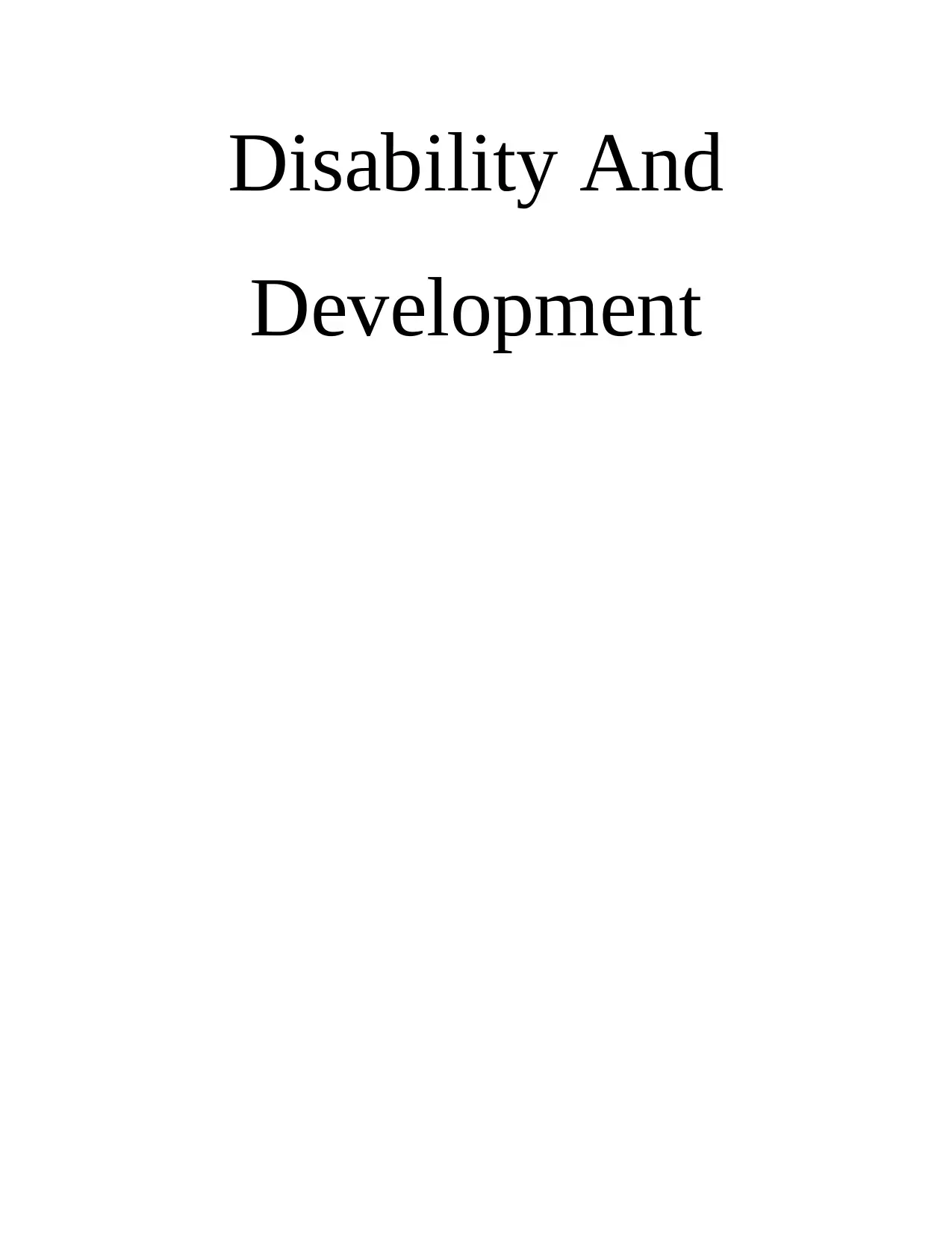
Disability And
Development
Development
Paraphrase This Document
Need a fresh take? Get an instant paraphrase of this document with our AI Paraphraser
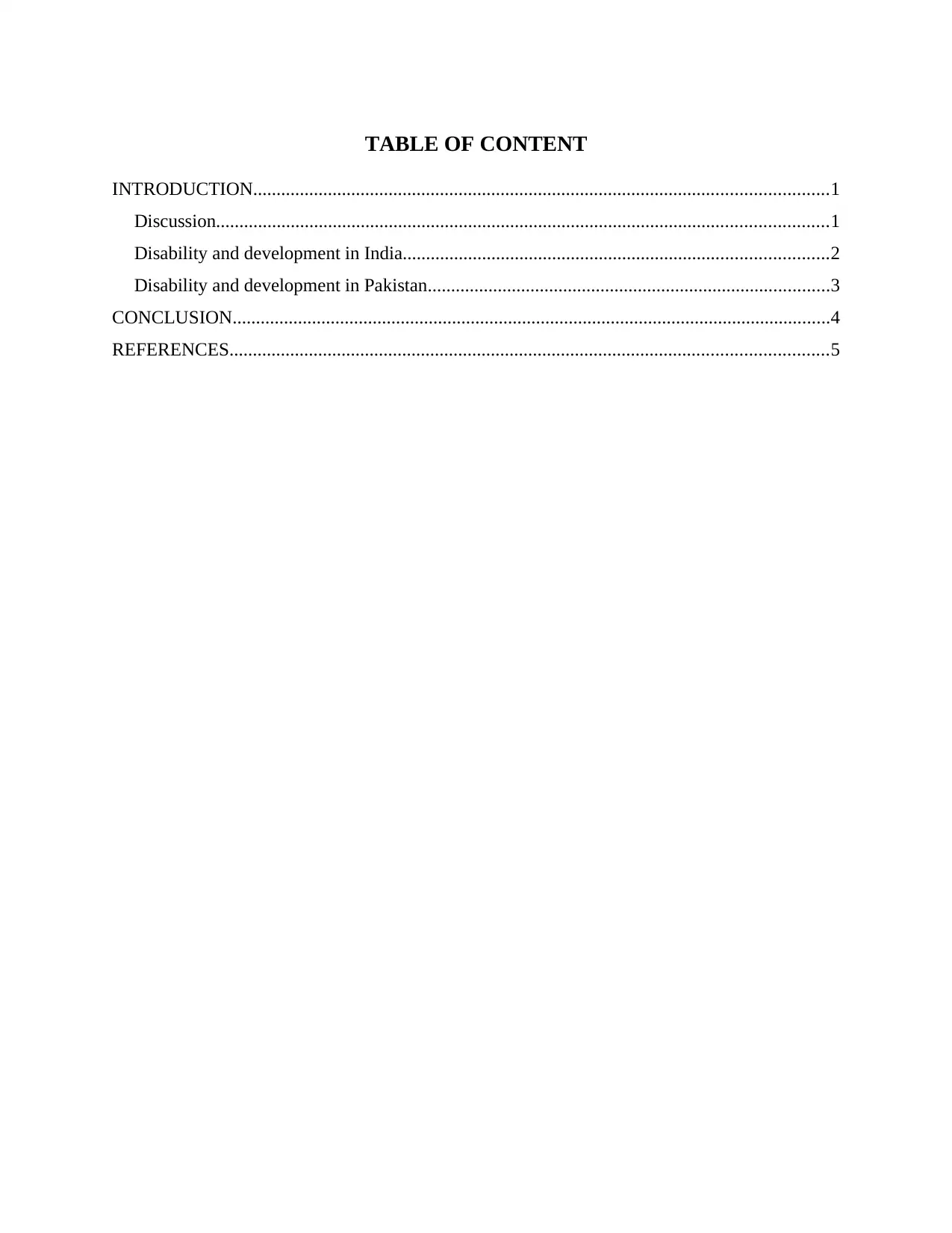
TABLE OF CONTENT
INTRODUCTION...........................................................................................................................1
Discussion...................................................................................................................................1
Disability and development in India...........................................................................................2
Disability and development in Pakistan......................................................................................3
CONCLUSION................................................................................................................................4
REFERENCES................................................................................................................................5
INTRODUCTION...........................................................................................................................1
Discussion...................................................................................................................................1
Disability and development in India...........................................................................................2
Disability and development in Pakistan......................................................................................3
CONCLUSION................................................................................................................................4
REFERENCES................................................................................................................................5
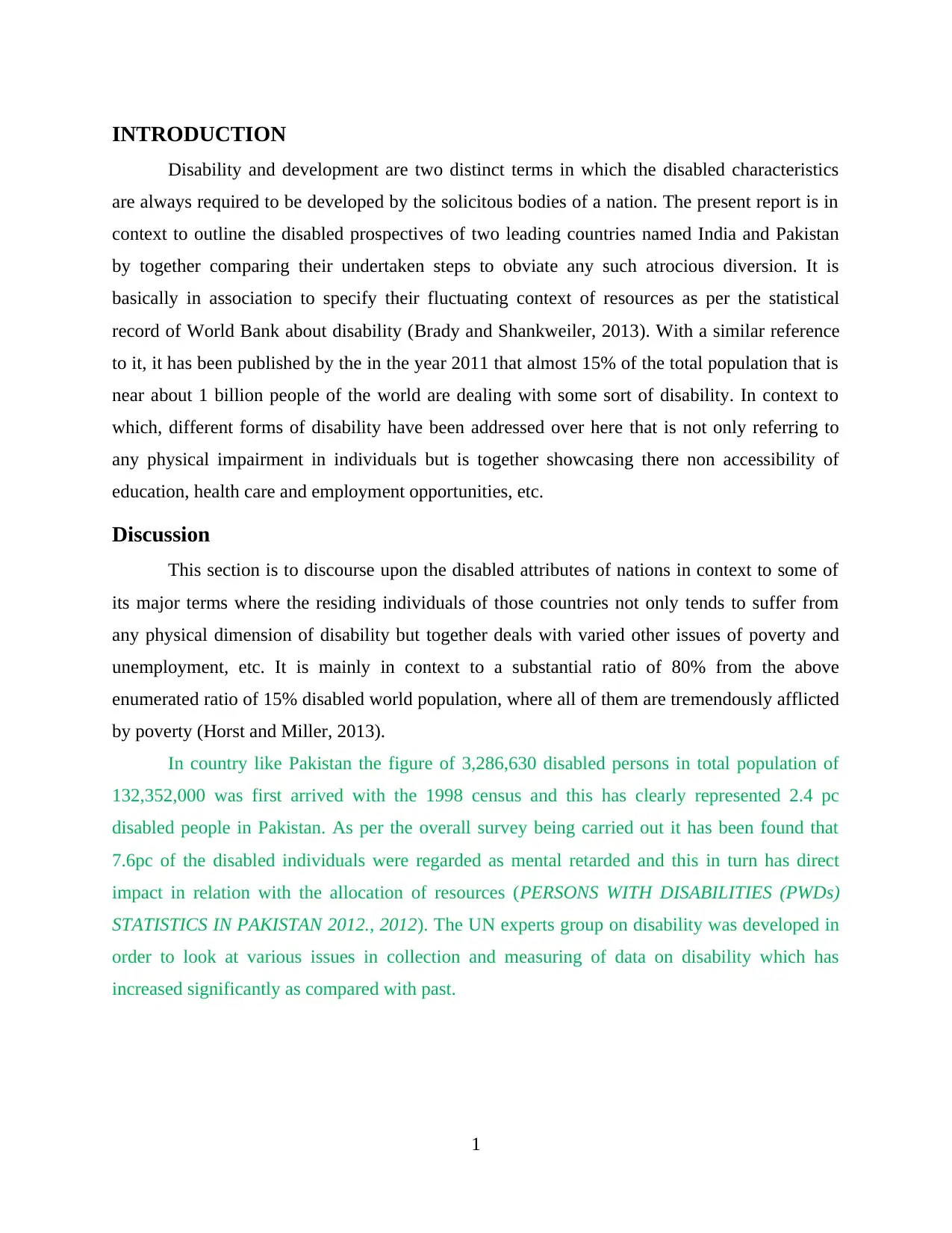
INTRODUCTION
Disability and development are two distinct terms in which the disabled characteristics
are always required to be developed by the solicitous bodies of a nation. The present report is in
context to outline the disabled prospectives of two leading countries named India and Pakistan
by together comparing their undertaken steps to obviate any such atrocious diversion. It is
basically in association to specify their fluctuating context of resources as per the statistical
record of World Bank about disability (Brady and Shankweiler, 2013). With a similar reference
to it, it has been published by the in the year 2011 that almost 15% of the total population that is
near about 1 billion people of the world are dealing with some sort of disability. In context to
which, different forms of disability have been addressed over here that is not only referring to
any physical impairment in individuals but is together showcasing there non accessibility of
education, health care and employment opportunities, etc.
Discussion
This section is to discourse upon the disabled attributes of nations in context to some of
its major terms where the residing individuals of those countries not only tends to suffer from
any physical dimension of disability but together deals with varied other issues of poverty and
unemployment, etc. It is mainly in context to a substantial ratio of 80% from the above
enumerated ratio of 15% disabled world population, where all of them are tremendously afflicted
by poverty (Horst and Miller, 2013).
In country like Pakistan the figure of 3,286,630 disabled persons in total population of
132,352,000 was first arrived with the 1998 census and this has clearly represented 2.4 pc
disabled people in Pakistan. As per the overall survey being carried out it has been found that
7.6pc of the disabled individuals were regarded as mental retarded and this in turn has direct
impact in relation with the allocation of resources (PERSONS WITH DISABILITIES (PWDs)
STATISTICS IN PAKISTAN 2012., 2012). The UN experts group on disability was developed in
order to look at various issues in collection and measuring of data on disability which has
increased significantly as compared with past.
1
Disability and development are two distinct terms in which the disabled characteristics
are always required to be developed by the solicitous bodies of a nation. The present report is in
context to outline the disabled prospectives of two leading countries named India and Pakistan
by together comparing their undertaken steps to obviate any such atrocious diversion. It is
basically in association to specify their fluctuating context of resources as per the statistical
record of World Bank about disability (Brady and Shankweiler, 2013). With a similar reference
to it, it has been published by the in the year 2011 that almost 15% of the total population that is
near about 1 billion people of the world are dealing with some sort of disability. In context to
which, different forms of disability have been addressed over here that is not only referring to
any physical impairment in individuals but is together showcasing there non accessibility of
education, health care and employment opportunities, etc.
Discussion
This section is to discourse upon the disabled attributes of nations in context to some of
its major terms where the residing individuals of those countries not only tends to suffer from
any physical dimension of disability but together deals with varied other issues of poverty and
unemployment, etc. It is mainly in context to a substantial ratio of 80% from the above
enumerated ratio of 15% disabled world population, where all of them are tremendously afflicted
by poverty (Horst and Miller, 2013).
In country like Pakistan the figure of 3,286,630 disabled persons in total population of
132,352,000 was first arrived with the 1998 census and this has clearly represented 2.4 pc
disabled people in Pakistan. As per the overall survey being carried out it has been found that
7.6pc of the disabled individuals were regarded as mental retarded and this in turn has direct
impact in relation with the allocation of resources (PERSONS WITH DISABILITIES (PWDs)
STATISTICS IN PAKISTAN 2012., 2012). The UN experts group on disability was developed in
order to look at various issues in collection and measuring of data on disability which has
increased significantly as compared with past.
1
⊘ This is a preview!⊘
Do you want full access?
Subscribe today to unlock all pages.

Trusted by 1+ million students worldwide
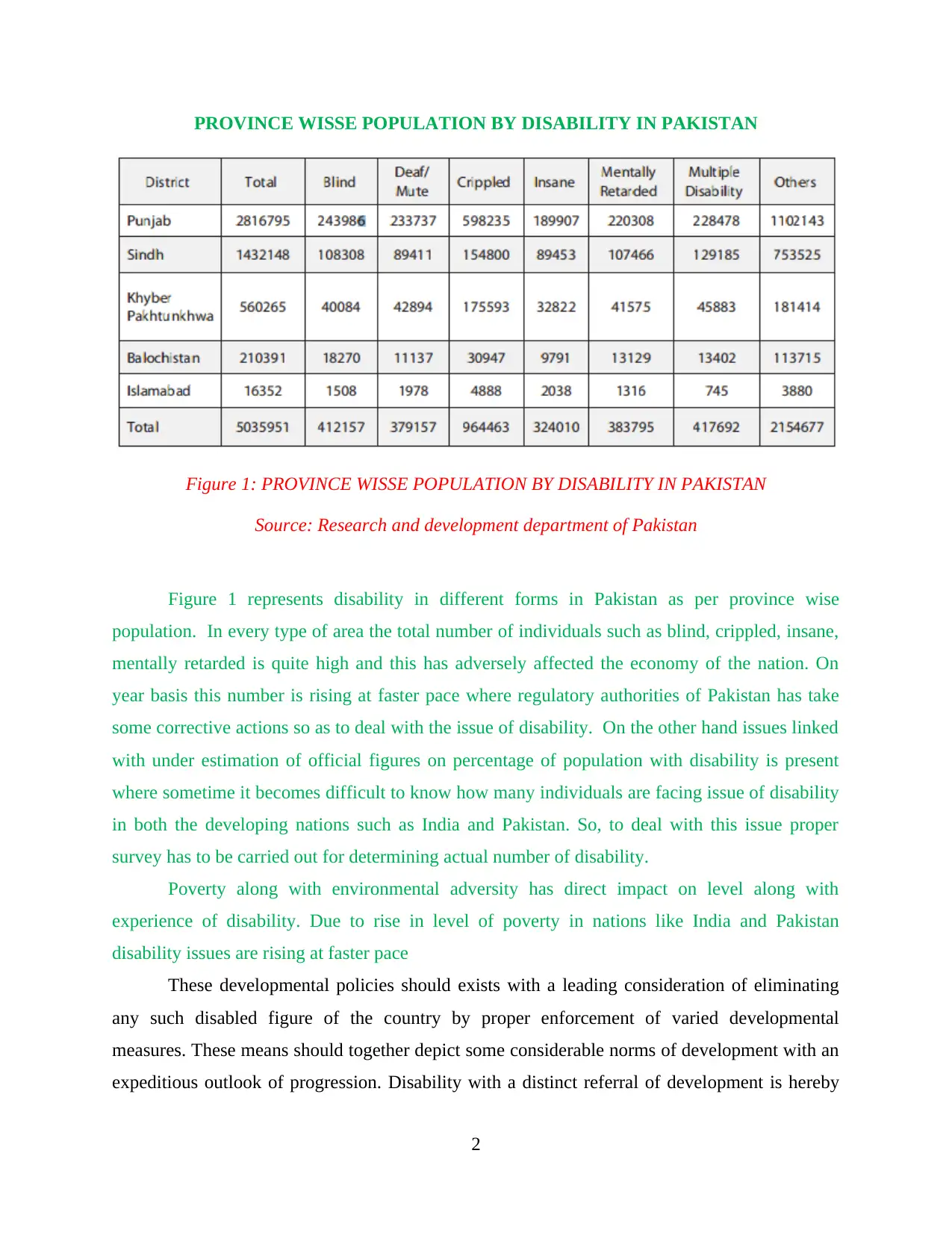
PROVINCE WISSE POPULATION BY DISABILITY IN PAKISTAN
Figure 1: PROVINCE WISSE POPULATION BY DISABILITY IN PAKISTAN
Source: Research and development department of Pakistan
Figure 1 represents disability in different forms in Pakistan as per province wise
population. In every type of area the total number of individuals such as blind, crippled, insane,
mentally retarded is quite high and this has adversely affected the economy of the nation. On
year basis this number is rising at faster pace where regulatory authorities of Pakistan has take
some corrective actions so as to deal with the issue of disability. On the other hand issues linked
with under estimation of official figures on percentage of population with disability is present
where sometime it becomes difficult to know how many individuals are facing issue of disability
in both the developing nations such as India and Pakistan. So, to deal with this issue proper
survey has to be carried out for determining actual number of disability.
Poverty along with environmental adversity has direct impact on level along with
experience of disability. Due to rise in level of poverty in nations like India and Pakistan
disability issues are rising at faster pace
These developmental policies should exists with a leading consideration of eliminating
any such disabled figure of the country by proper enforcement of varied developmental
measures. These means should together depict some considerable norms of development with an
expeditious outlook of progression. Disability with a distinct referral of development is hereby
2
Figure 1: PROVINCE WISSE POPULATION BY DISABILITY IN PAKISTAN
Source: Research and development department of Pakistan
Figure 1 represents disability in different forms in Pakistan as per province wise
population. In every type of area the total number of individuals such as blind, crippled, insane,
mentally retarded is quite high and this has adversely affected the economy of the nation. On
year basis this number is rising at faster pace where regulatory authorities of Pakistan has take
some corrective actions so as to deal with the issue of disability. On the other hand issues linked
with under estimation of official figures on percentage of population with disability is present
where sometime it becomes difficult to know how many individuals are facing issue of disability
in both the developing nations such as India and Pakistan. So, to deal with this issue proper
survey has to be carried out for determining actual number of disability.
Poverty along with environmental adversity has direct impact on level along with
experience of disability. Due to rise in level of poverty in nations like India and Pakistan
disability issues are rising at faster pace
These developmental policies should exists with a leading consideration of eliminating
any such disabled figure of the country by proper enforcement of varied developmental
measures. These means should together depict some considerable norms of development with an
expeditious outlook of progression. Disability with a distinct referral of development is hereby
2
Paraphrase This Document
Need a fresh take? Get an instant paraphrase of this document with our AI Paraphraser
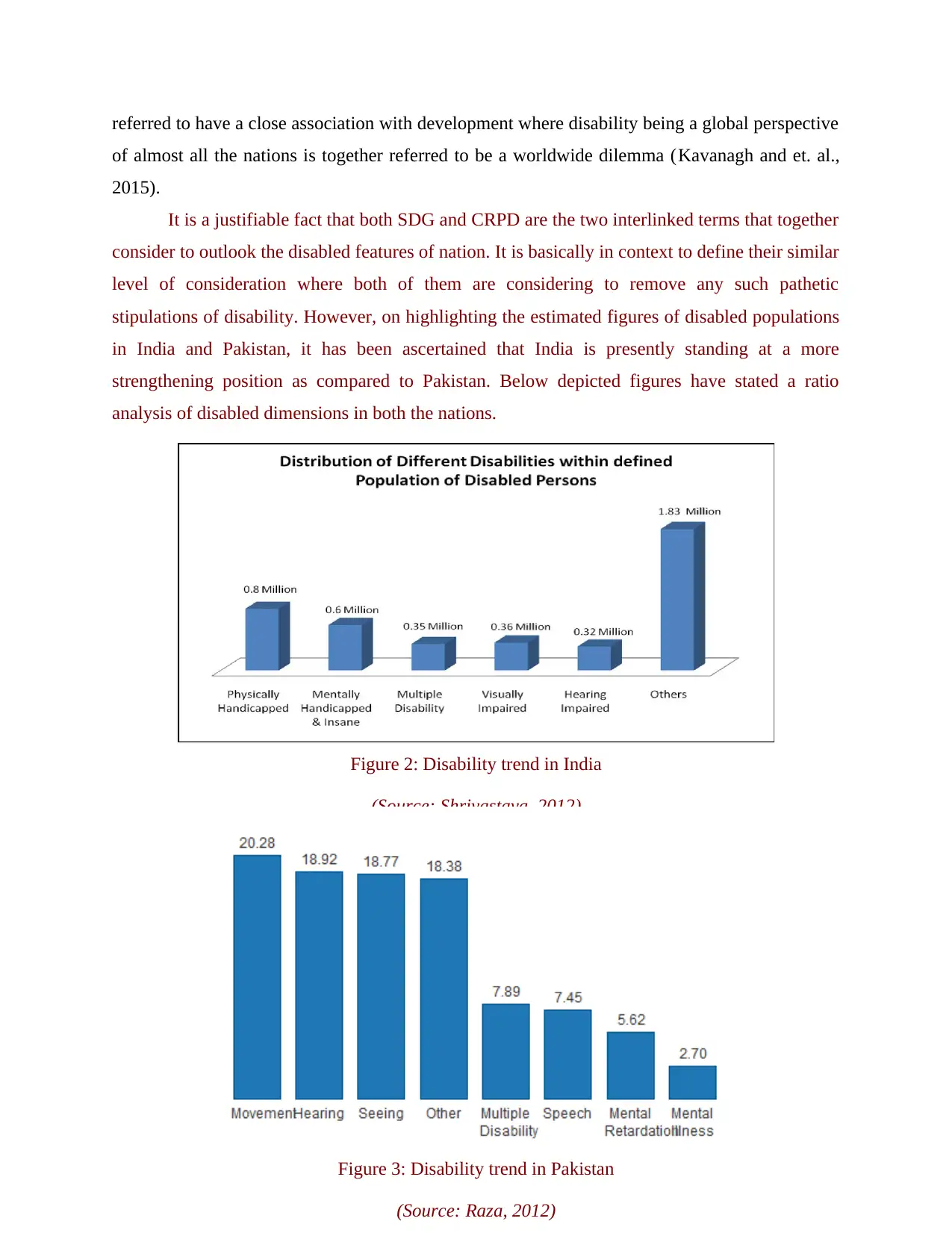
referred to have a close association with development where disability being a global perspective
of almost all the nations is together referred to be a worldwide dilemma (Kavanagh and et. al.,
2015).
It is a justifiable fact that both SDG and CRPD are the two interlinked terms that together
consider to outlook the disabled features of nation. It is basically in context to define their similar
level of consideration where both of them are considering to remove any such pathetic
stipulations of disability. However, on highlighting the estimated figures of disabled populations
in India and Pakistan, it has been ascertained that India is presently standing at a more
strengthening position as compared to Pakistan. Below depicted figures have stated a ratio
analysis of disabled dimensions in both the nations.
3
Figure 2: Disability trend in India
(Source: Shrivastava, 2012)
Figure 3: Disability trend in Pakistan
(Source: Raza, 2012)
of almost all the nations is together referred to be a worldwide dilemma (Kavanagh and et. al.,
2015).
It is a justifiable fact that both SDG and CRPD are the two interlinked terms that together
consider to outlook the disabled features of nation. It is basically in context to define their similar
level of consideration where both of them are considering to remove any such pathetic
stipulations of disability. However, on highlighting the estimated figures of disabled populations
in India and Pakistan, it has been ascertained that India is presently standing at a more
strengthening position as compared to Pakistan. Below depicted figures have stated a ratio
analysis of disabled dimensions in both the nations.
3
Figure 2: Disability trend in India
(Source: Shrivastava, 2012)
Figure 3: Disability trend in Pakistan
(Source: Raza, 2012)
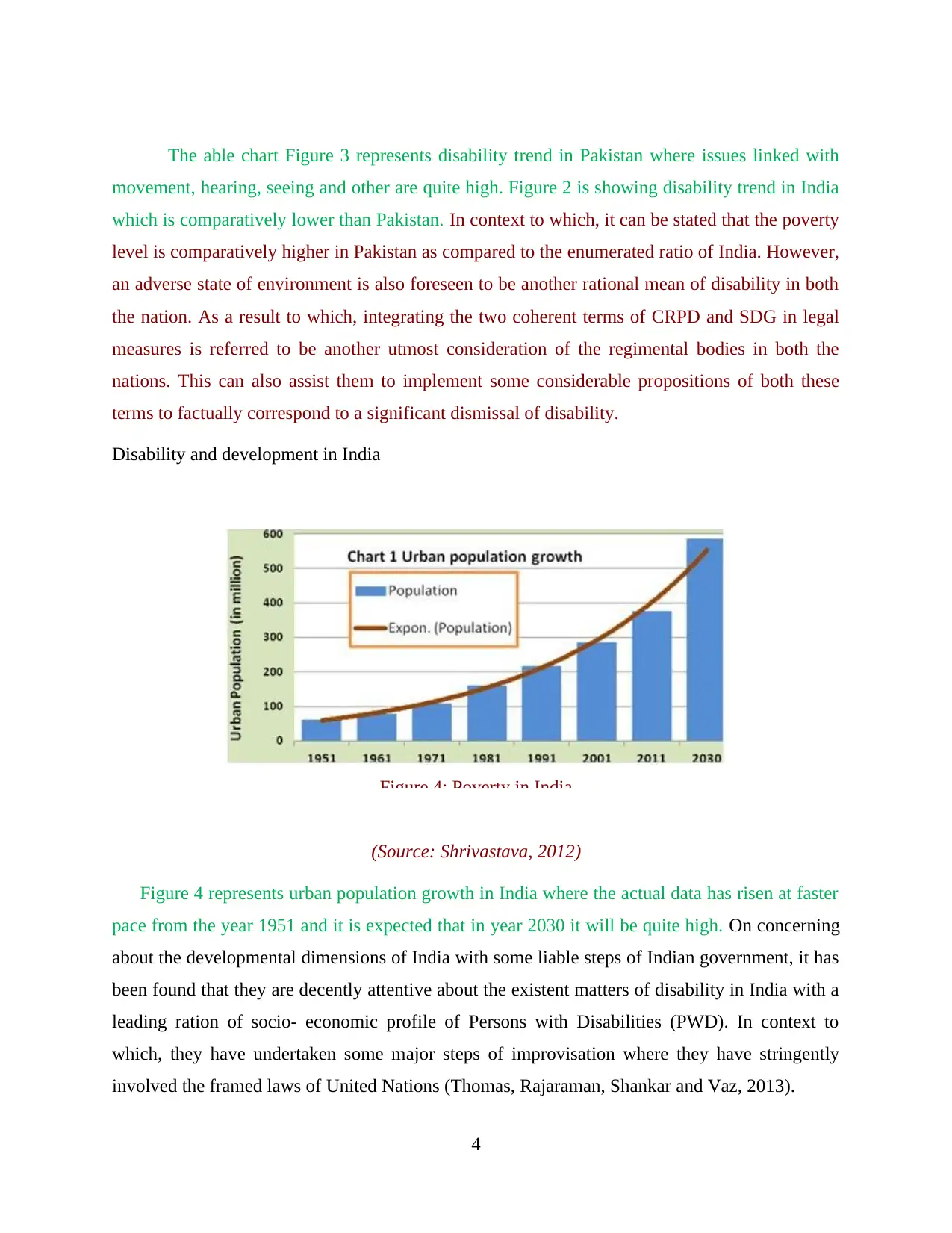
The able chart Figure 3 represents disability trend in Pakistan where issues linked with
movement, hearing, seeing and other are quite high. Figure 2 is showing disability trend in India
which is comparatively lower than Pakistan. In context to which, it can be stated that the poverty
level is comparatively higher in Pakistan as compared to the enumerated ratio of India. However,
an adverse state of environment is also foreseen to be another rational mean of disability in both
the nation. As a result to which, integrating the two coherent terms of CRPD and SDG in legal
measures is referred to be another utmost consideration of the regimental bodies in both the
nations. This can also assist them to implement some considerable propositions of both these
terms to factually correspond to a significant dismissal of disability.
Disability and development in India
(Source: Shrivastava, 2012)
Figure 4 represents urban population growth in India where the actual data has risen at faster
pace from the year 1951 and it is expected that in year 2030 it will be quite high. On concerning
about the developmental dimensions of India with some liable steps of Indian government, it has
been found that they are decently attentive about the existent matters of disability in India with a
leading ration of socio- economic profile of Persons with Disabilities (PWD). In context to
which, they have undertaken some major steps of improvisation where they have stringently
involved the framed laws of United Nations (Thomas, Rajaraman, Shankar and Vaz, 2013).
4
Figure 4: Poverty in India
movement, hearing, seeing and other are quite high. Figure 2 is showing disability trend in India
which is comparatively lower than Pakistan. In context to which, it can be stated that the poverty
level is comparatively higher in Pakistan as compared to the enumerated ratio of India. However,
an adverse state of environment is also foreseen to be another rational mean of disability in both
the nation. As a result to which, integrating the two coherent terms of CRPD and SDG in legal
measures is referred to be another utmost consideration of the regimental bodies in both the
nations. This can also assist them to implement some considerable propositions of both these
terms to factually correspond to a significant dismissal of disability.
Disability and development in India
(Source: Shrivastava, 2012)
Figure 4 represents urban population growth in India where the actual data has risen at faster
pace from the year 1951 and it is expected that in year 2030 it will be quite high. On concerning
about the developmental dimensions of India with some liable steps of Indian government, it has
been found that they are decently attentive about the existent matters of disability in India with a
leading ration of socio- economic profile of Persons with Disabilities (PWD). In context to
which, they have undertaken some major steps of improvisation where they have stringently
involved the framed laws of United Nations (Thomas, Rajaraman, Shankar and Vaz, 2013).
4
Figure 4: Poverty in India
⊘ This is a preview!⊘
Do you want full access?
Subscribe today to unlock all pages.

Trusted by 1+ million students worldwide
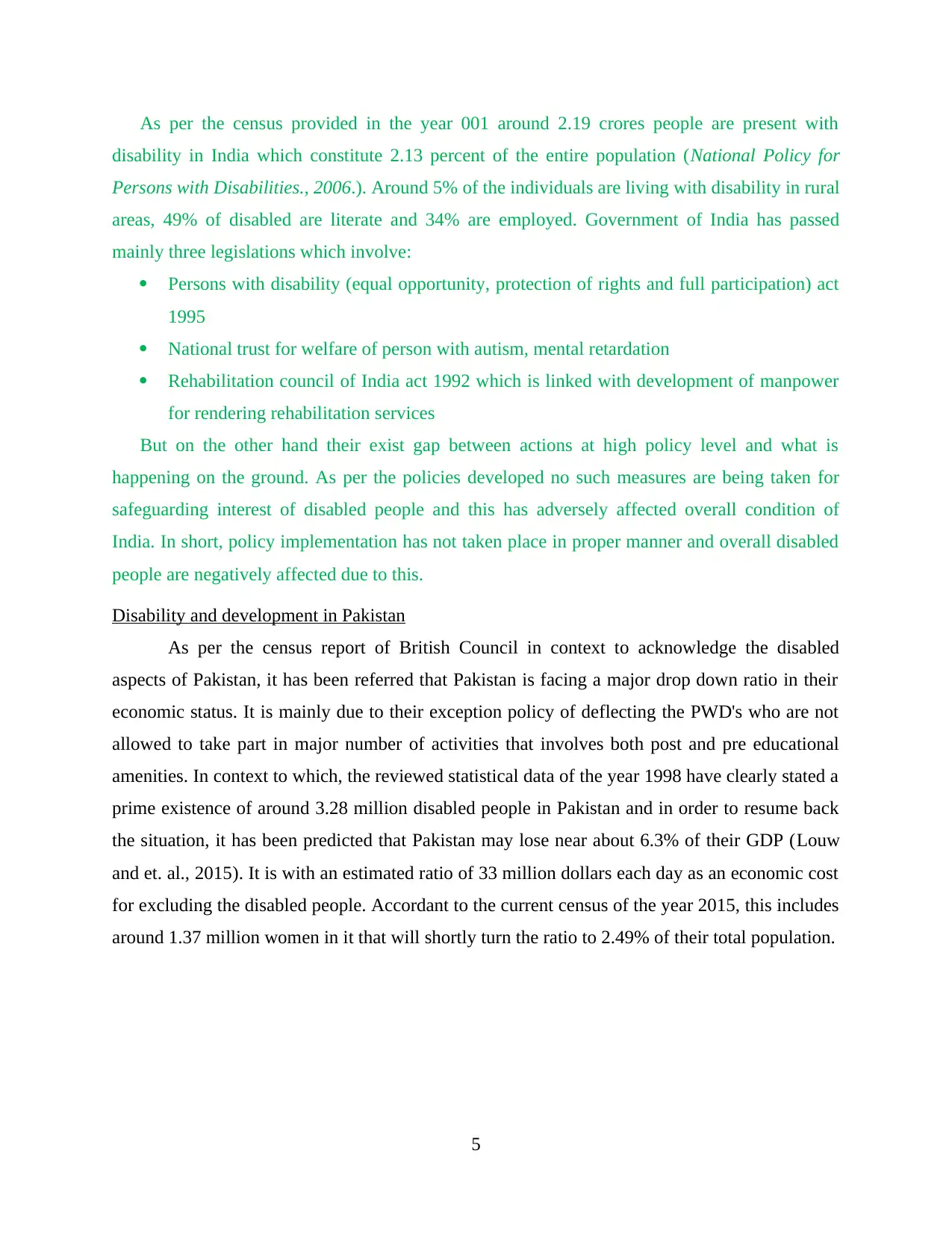
As per the census provided in the year 001 around 2.19 crores people are present with
disability in India which constitute 2.13 percent of the entire population (National Policy for
Persons with Disabilities., 2006.). Around 5% of the individuals are living with disability in rural
areas, 49% of disabled are literate and 34% are employed. Government of India has passed
mainly three legislations which involve:
Persons with disability (equal opportunity, protection of rights and full participation) act
1995
National trust for welfare of person with autism, mental retardation
Rehabilitation council of India act 1992 which is linked with development of manpower
for rendering rehabilitation services
But on the other hand their exist gap between actions at high policy level and what is
happening on the ground. As per the policies developed no such measures are being taken for
safeguarding interest of disabled people and this has adversely affected overall condition of
India. In short, policy implementation has not taken place in proper manner and overall disabled
people are negatively affected due to this.
Disability and development in Pakistan
As per the census report of British Council in context to acknowledge the disabled
aspects of Pakistan, it has been referred that Pakistan is facing a major drop down ratio in their
economic status. It is mainly due to their exception policy of deflecting the PWD's who are not
allowed to take part in major number of activities that involves both post and pre educational
amenities. In context to which, the reviewed statistical data of the year 1998 have clearly stated a
prime existence of around 3.28 million disabled people in Pakistan and in order to resume back
the situation, it has been predicted that Pakistan may lose near about 6.3% of their GDP (Louw
and et. al., 2015). It is with an estimated ratio of 33 million dollars each day as an economic cost
for excluding the disabled people. Accordant to the current census of the year 2015, this includes
around 1.37 million women in it that will shortly turn the ratio to 2.49% of their total population.
5
disability in India which constitute 2.13 percent of the entire population (National Policy for
Persons with Disabilities., 2006.). Around 5% of the individuals are living with disability in rural
areas, 49% of disabled are literate and 34% are employed. Government of India has passed
mainly three legislations which involve:
Persons with disability (equal opportunity, protection of rights and full participation) act
1995
National trust for welfare of person with autism, mental retardation
Rehabilitation council of India act 1992 which is linked with development of manpower
for rendering rehabilitation services
But on the other hand their exist gap between actions at high policy level and what is
happening on the ground. As per the policies developed no such measures are being taken for
safeguarding interest of disabled people and this has adversely affected overall condition of
India. In short, policy implementation has not taken place in proper manner and overall disabled
people are negatively affected due to this.
Disability and development in Pakistan
As per the census report of British Council in context to acknowledge the disabled
aspects of Pakistan, it has been referred that Pakistan is facing a major drop down ratio in their
economic status. It is mainly due to their exception policy of deflecting the PWD's who are not
allowed to take part in major number of activities that involves both post and pre educational
amenities. In context to which, the reviewed statistical data of the year 1998 have clearly stated a
prime existence of around 3.28 million disabled people in Pakistan and in order to resume back
the situation, it has been predicted that Pakistan may lose near about 6.3% of their GDP (Louw
and et. al., 2015). It is with an estimated ratio of 33 million dollars each day as an economic cost
for excluding the disabled people. Accordant to the current census of the year 2015, this includes
around 1.37 million women in it that will shortly turn the ratio to 2.49% of their total population.
5
Paraphrase This Document
Need a fresh take? Get an instant paraphrase of this document with our AI Paraphraser
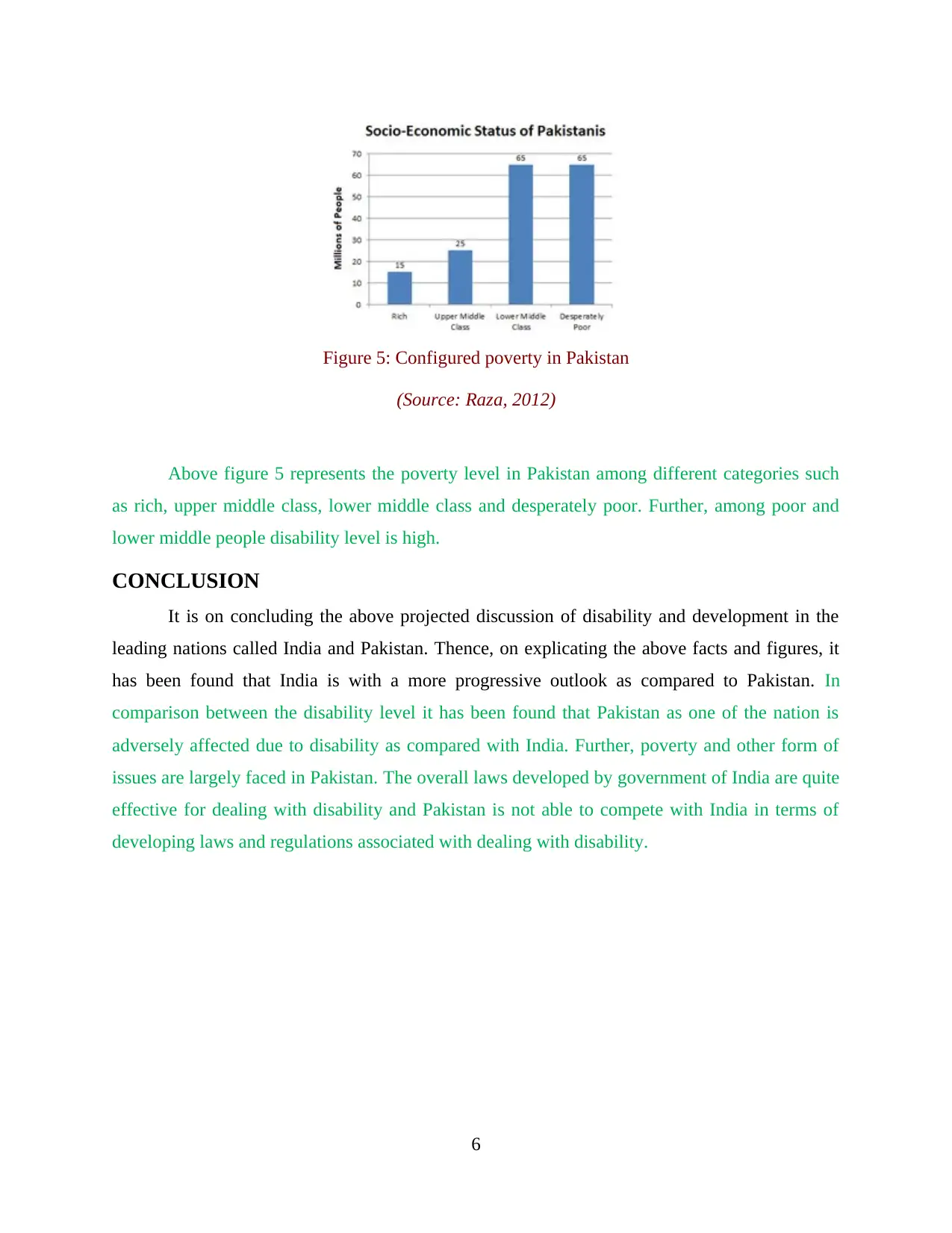
Figure 5: Configured poverty in Pakistan
(Source: Raza, 2012)
Above figure 5 represents the poverty level in Pakistan among different categories such
as rich, upper middle class, lower middle class and desperately poor. Further, among poor and
lower middle people disability level is high.
CONCLUSION
It is on concluding the above projected discussion of disability and development in the
leading nations called India and Pakistan. Thence, on explicating the above facts and figures, it
has been found that India is with a more progressive outlook as compared to Pakistan. In
comparison between the disability level it has been found that Pakistan as one of the nation is
adversely affected due to disability as compared with India. Further, poverty and other form of
issues are largely faced in Pakistan. The overall laws developed by government of India are quite
effective for dealing with disability and Pakistan is not able to compete with India in terms of
developing laws and regulations associated with dealing with disability.
6
(Source: Raza, 2012)
Above figure 5 represents the poverty level in Pakistan among different categories such
as rich, upper middle class, lower middle class and desperately poor. Further, among poor and
lower middle people disability level is high.
CONCLUSION
It is on concluding the above projected discussion of disability and development in the
leading nations called India and Pakistan. Thence, on explicating the above facts and figures, it
has been found that India is with a more progressive outlook as compared to Pakistan. In
comparison between the disability level it has been found that Pakistan as one of the nation is
adversely affected due to disability as compared with India. Further, poverty and other form of
issues are largely faced in Pakistan. The overall laws developed by government of India are quite
effective for dealing with disability and Pakistan is not able to compete with India in terms of
developing laws and regulations associated with dealing with disability.
6
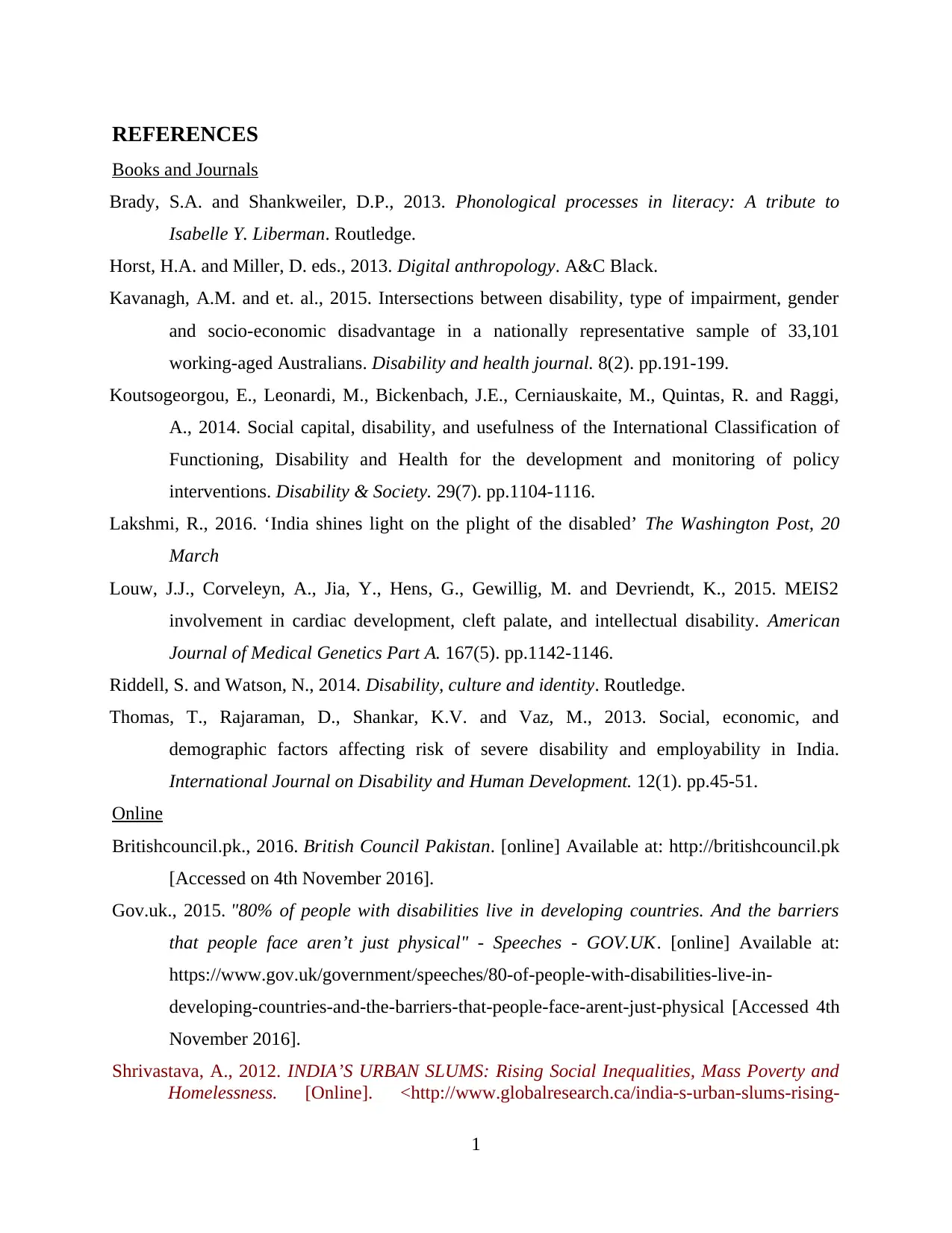
REFERENCES
Books and Journals
Brady, S.A. and Shankweiler, D.P., 2013. Phonological processes in literacy: A tribute to
Isabelle Y. Liberman. Routledge.
Horst, H.A. and Miller, D. eds., 2013. Digital anthropology. A&C Black.
Kavanagh, A.M. and et. al., 2015. Intersections between disability, type of impairment, gender
and socio-economic disadvantage in a nationally representative sample of 33,101
working-aged Australians. Disability and health journal. 8(2). pp.191-199.
Koutsogeorgou, E., Leonardi, M., Bickenbach, J.E., Cerniauskaite, M., Quintas, R. and Raggi,
A., 2014. Social capital, disability, and usefulness of the International Classification of
Functioning, Disability and Health for the development and monitoring of policy
interventions. Disability & Society. 29(7). pp.1104-1116.
Lakshmi, R., 2016. ‘India shines light on the plight of the disabled’ The Washington Post, 20
March
Louw, J.J., Corveleyn, A., Jia, Y., Hens, G., Gewillig, M. and Devriendt, K., 2015. MEIS2
involvement in cardiac development, cleft palate, and intellectual disability. American
Journal of Medical Genetics Part A. 167(5). pp.1142-1146.
Riddell, S. and Watson, N., 2014. Disability, culture and identity. Routledge.
Thomas, T., Rajaraman, D., Shankar, K.V. and Vaz, M., 2013. Social, economic, and
demographic factors affecting risk of severe disability and employability in India.
International Journal on Disability and Human Development. 12(1). pp.45-51.
Online
Britishcouncil.pk., 2016. British Council Pakistan. [online] Available at: http://britishcouncil.pk
[Accessed on 4th November 2016].
Gov.uk., 2015. "80% of people with disabilities live in developing countries. And the barriers
that people face aren’t just physical" - Speeches - GOV.UK. [online] Available at:
https://www.gov.uk/government/speeches/80-of-people-with-disabilities-live-in-
developing-countries-and-the-barriers-that-people-face-arent-just-physical [Accessed 4th
November 2016].
Shrivastava, A., 2012. INDIA’S URBAN SLUMS: Rising Social Inequalities, Mass Poverty and
Homelessness. [Online]. <http://www.globalresearch.ca/india-s-urban-slums-rising-
1
Books and Journals
Brady, S.A. and Shankweiler, D.P., 2013. Phonological processes in literacy: A tribute to
Isabelle Y. Liberman. Routledge.
Horst, H.A. and Miller, D. eds., 2013. Digital anthropology. A&C Black.
Kavanagh, A.M. and et. al., 2015. Intersections between disability, type of impairment, gender
and socio-economic disadvantage in a nationally representative sample of 33,101
working-aged Australians. Disability and health journal. 8(2). pp.191-199.
Koutsogeorgou, E., Leonardi, M., Bickenbach, J.E., Cerniauskaite, M., Quintas, R. and Raggi,
A., 2014. Social capital, disability, and usefulness of the International Classification of
Functioning, Disability and Health for the development and monitoring of policy
interventions. Disability & Society. 29(7). pp.1104-1116.
Lakshmi, R., 2016. ‘India shines light on the plight of the disabled’ The Washington Post, 20
March
Louw, J.J., Corveleyn, A., Jia, Y., Hens, G., Gewillig, M. and Devriendt, K., 2015. MEIS2
involvement in cardiac development, cleft palate, and intellectual disability. American
Journal of Medical Genetics Part A. 167(5). pp.1142-1146.
Riddell, S. and Watson, N., 2014. Disability, culture and identity. Routledge.
Thomas, T., Rajaraman, D., Shankar, K.V. and Vaz, M., 2013. Social, economic, and
demographic factors affecting risk of severe disability and employability in India.
International Journal on Disability and Human Development. 12(1). pp.45-51.
Online
Britishcouncil.pk., 2016. British Council Pakistan. [online] Available at: http://britishcouncil.pk
[Accessed on 4th November 2016].
Gov.uk., 2015. "80% of people with disabilities live in developing countries. And the barriers
that people face aren’t just physical" - Speeches - GOV.UK. [online] Available at:
https://www.gov.uk/government/speeches/80-of-people-with-disabilities-live-in-
developing-countries-and-the-barriers-that-people-face-arent-just-physical [Accessed 4th
November 2016].
Shrivastava, A., 2012. INDIA’S URBAN SLUMS: Rising Social Inequalities, Mass Poverty and
Homelessness. [Online]. <http://www.globalresearch.ca/india-s-urban-slums-rising-
1
⊘ This is a preview!⊘
Do you want full access?
Subscribe today to unlock all pages.

Trusted by 1+ million students worldwide
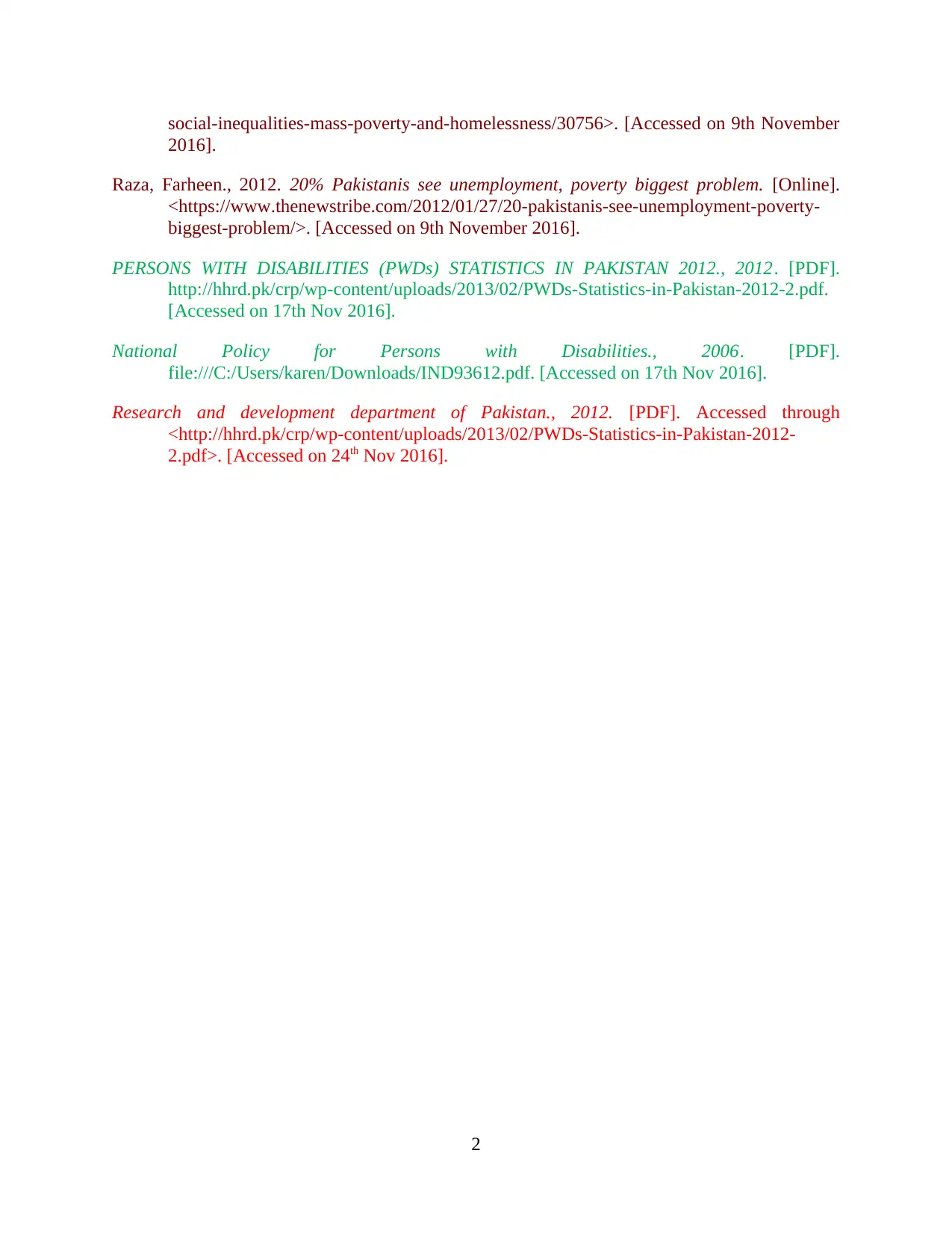
social-inequalities-mass-poverty-and-homelessness/30756>. [Accessed on 9th November
2016].
Raza, Farheen., 2012. 20% Pakistanis see unemployment, poverty biggest problem. [Online].
<https://www.thenewstribe.com/2012/01/27/20-pakistanis-see-unemployment-poverty-
biggest-problem/>. [Accessed on 9th November 2016].
PERSONS WITH DISABILITIES (PWDs) STATISTICS IN PAKISTAN 2012., 2012. [PDF].
http://hhrd.pk/crp/wp-content/uploads/2013/02/PWDs-Statistics-in-Pakistan-2012-2.pdf.
[Accessed on 17th Nov 2016].
National Policy for Persons with Disabilities., 2006. [PDF].
file:///C:/Users/karen/Downloads/IND93612.pdf. [Accessed on 17th Nov 2016].
Research and development department of Pakistan., 2012. [PDF]. Accessed through
<http://hhrd.pk/crp/wp-content/uploads/2013/02/PWDs-Statistics-in-Pakistan-2012-
2.pdf>. [Accessed on 24th Nov 2016].
2
2016].
Raza, Farheen., 2012. 20% Pakistanis see unemployment, poverty biggest problem. [Online].
<https://www.thenewstribe.com/2012/01/27/20-pakistanis-see-unemployment-poverty-
biggest-problem/>. [Accessed on 9th November 2016].
PERSONS WITH DISABILITIES (PWDs) STATISTICS IN PAKISTAN 2012., 2012. [PDF].
http://hhrd.pk/crp/wp-content/uploads/2013/02/PWDs-Statistics-in-Pakistan-2012-2.pdf.
[Accessed on 17th Nov 2016].
National Policy for Persons with Disabilities., 2006. [PDF].
file:///C:/Users/karen/Downloads/IND93612.pdf. [Accessed on 17th Nov 2016].
Research and development department of Pakistan., 2012. [PDF]. Accessed through
<http://hhrd.pk/crp/wp-content/uploads/2013/02/PWDs-Statistics-in-Pakistan-2012-
2.pdf>. [Accessed on 24th Nov 2016].
2
Paraphrase This Document
Need a fresh take? Get an instant paraphrase of this document with our AI Paraphraser

1
1 out of 11
Related Documents
Your All-in-One AI-Powered Toolkit for Academic Success.
+13062052269
info@desklib.com
Available 24*7 on WhatsApp / Email
![[object Object]](/_next/static/media/star-bottom.7253800d.svg)
Unlock your academic potential
Copyright © 2020–2025 A2Z Services. All Rights Reserved. Developed and managed by ZUCOL.




